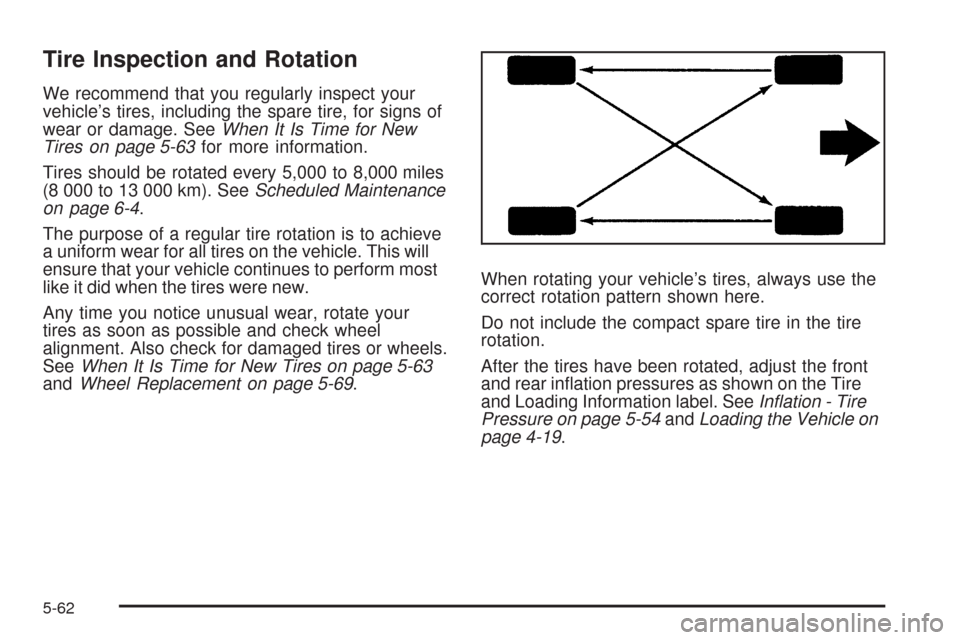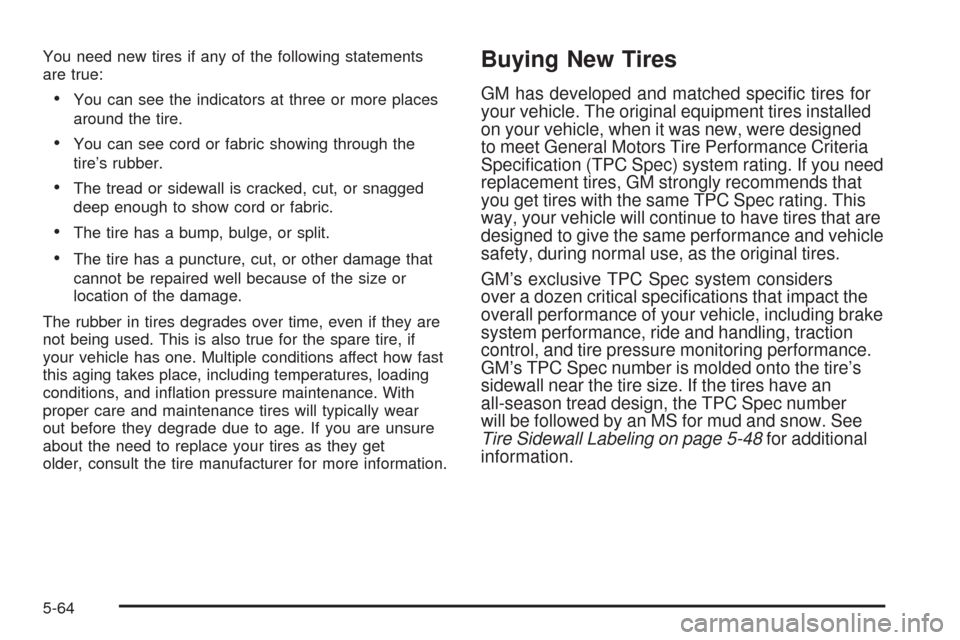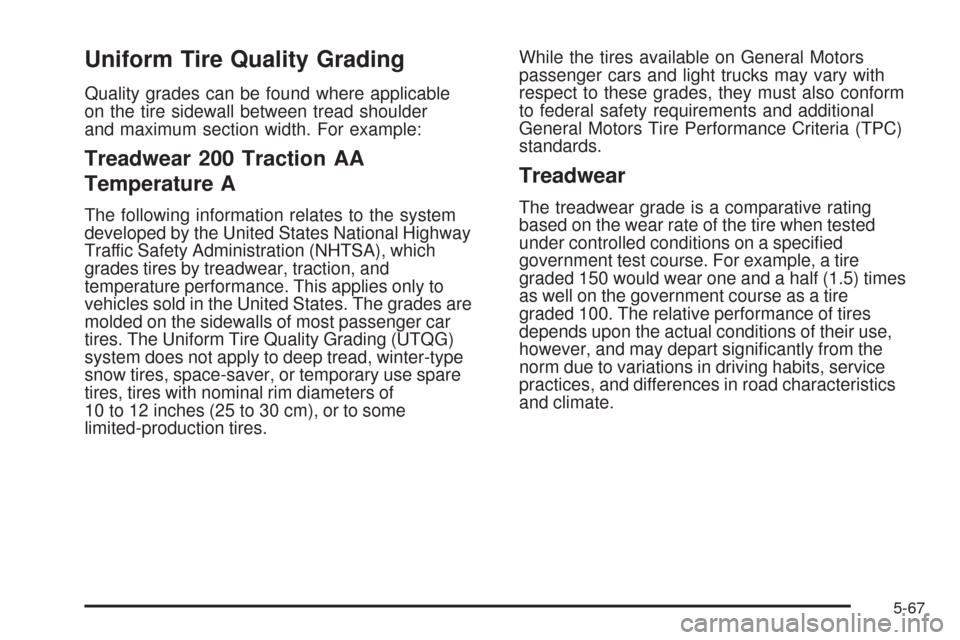Page 372 of 464

Tire Inspection and Rotation
We recommend that you regularly inspect your
vehicle’s tires, including the spare tire, for signs of
wear or damage. SeeWhen It Is Time for New
Tires on page 5-63for more information.
Tires should be rotated every 5,000 to 8,000 miles
(8 000 to 13 000 km). SeeScheduled Maintenance
on page 6-4.
The purpose of a regular tire rotation is to achieve
a uniform wear for all tires on the vehicle. This will
ensure that your vehicle continues to perform most
like it did when the tires were new.
Any time you notice unusual wear, rotate your
tires as soon as possible and check wheel
alignment. Also check for damaged tires or wheels.
SeeWhen It Is Time for New Tires on page 5-63
andWheel Replacement on page 5-69.When rotating your vehicle’s tires, always use the
correct rotation pattern shown here.
Do not include the compact spare tire in the tire
rotation.
After the tires have been rotated, adjust the front
and rear in�ation pressures as shown on the Tire
and Loading Information label. SeeInflation - Tire
Pressure on page 5-54andLoading the Vehicle on
page 4-19.
5-62
Page 373 of 464

Reset the Tire Pressure Monitor System. SeeTire
Pressure Monitor Operation on page 5-58.
Make certain that all wheel nuts are properly
tightened. See “Wheel Nut Torque” under
Capacities and Specifications on page 5-104.
{CAUTION:
Rust or dirt on a wheel, or on the parts to
which it is fastened, can make wheel nuts
become loose after time. The wheel could
come off and cause an accident. When you
change a wheel, remove any rust or dirt from
places where the wheel attaches to the
vehicle. In an emergency, you can use a cloth
or a paper towel to do this; but be sure to use a
scraper or wire brush later, if needed, to get all
the rust or dirt off. SeeChanging a Flat Tire on
page 5-74.
Make sure the spare tire is stored securely.
Push, pull, and then try to rotate or turn the tire.
If it moves, tighten the cable. SeeStoring a Flat
or Spare Tire and Tools on page 5-86.
When It Is Time for New Tires
Various factors, such as maintenance, temperatures,
driving speeds, vehicle loading, and road conditions
in�uence when you need new tires.
One way to tell when it
is time for new tires is to
check the treadwear
indicators, which will
appear when your tires
have only 1/16 inch
(1.6 mm) or less of
tread remaining.
5-63
Page 374 of 464

You need new tires if any of the following statements
are true:
You can see the indicators at three or more places
around the tire.
You can see cord or fabric showing through the
tire’s rubber.
The tread or sidewall is cracked, cut, or snagged
deep enough to show cord or fabric.
The tire has a bump, bulge, or split.
The tire has a puncture, cut, or other damage that
cannot be repaired well because of the size or
location of the damage.
The rubber in tires degrades over time, even if they are
not being used. This is also true for the spare tire, if
your vehicle has one. Multiple conditions affect how fast
this aging takes place, including temperatures, loading
conditions, and in�ation pressure maintenance. With
proper care and maintenance tires will typically wear
out before they degrade due to age. If you are unsure
about the need to replace your tires as they get
older, consult the tire manufacturer for more information.
Buying New Tires
GM has developed and matched speci�c tires for
your vehicle. The original equipment tires installed
on your vehicle, when it was new, were designed
to meet General Motors Tire Performance Criteria
Speci�cation (TPC Spec) system rating. If you need
replacement tires, GM strongly recommends that
you get tires with the same TPC Spec rating. This
way, your vehicle will continue to have tires that are
designed to give the same performance and vehicle
safety, during normal use, as the original tires.
GM’s exclusive TPC Spec system considers
over a dozen critical speci�cations that impact the
overall performance of your vehicle, including brake
system performance, ride and handling, traction
control, and tire pressure monitoring performance.
GM’s TPC Spec number is molded onto the tire’s
sidewall near the tire size. If the tires have an
all-season tread design, the TPC Spec number
will be followed by an MS for mud and snow. See
Tire Sidewall Labeling on page 5-48for additional
information.
5-64
Page 375 of 464

GM recommends replacing tires in sets of four.
This is because uniform tread depth on all tires
will help keep your vehicle performing most like
it did when the tires were new. Replacing less
than a full set of tires can affect the braking
and handling performance of your vehicle.
SeeTire Inspection and Rotation on page 5-62
for information on proper tire rotation.
{CAUTION:
Mixing tires could cause you to lose control
while driving. If you mix tires of different
sizes, brands, or types (radial and bias-belted
tires), the vehicle may not handle properly,
and you could have a crash. Using tires of
different sizes, brands, or types may also
cause damage to your vehicle. Be sure to
use the correct size, brand, and type of
tires on all wheels. It is all right to drive
with your compact spare temporarily, as
it was developed for use on your vehicle.
SeeCompact Spare Tire on page 5-88.
{CAUTION:
If you use bias-ply tires on the vehicle, the
wheel rim �anges could develop cracks after
many miles of driving. A tire and/or wheel
could fail suddenly, causing a crash. Use
only radial-ply tires with the wheels on the
vehicle.
If you must replace your vehicle’s tires with those
that do not have a TPC Spec number, make
sure they are the same size, load range, speed
rating, and construction type (radial and
bias-belted tires) as your vehicle’s original tires.
Vehicles that have a tire pressure monitoring
system could give an inaccurate low-pressure
warning if non-TPC Spec rated tires are installed
on your vehicle. Non-TPC Spec rated tires
may give a low-pressure warning that is higher
or lower than the proper warning level you would
get with TPC Spec rated tires. SeeTire Pressure
Monitor System on page 5-57.
5-65
Page 377 of 464

Uniform Tire Quality Grading
Quality grades can be found where applicable
on the tire sidewall between tread shoulder
and maximum section width. For example:
Treadwear 200 Traction AA
Temperature A
The following information relates to the system
developed by the United States National Highway
Traffic Safety Administration (NHTSA), which
grades tires by treadwear, traction, and
temperature performance. This applies only to
vehicles sold in the United States. The grades are
molded on the sidewalls of most passenger car
tires. The Uniform Tire Quality Grading (UTQG)
system does not apply to deep tread, winter-type
snow tires, space-saver, or temporary use spare
tires, tires with nominal rim diameters of
10 to 12 inches (25 to 30 cm), or to some
limited-production tires.While the tires available on General Motors
passenger cars and light trucks may vary with
respect to these grades, they must also conform
to federal safety requirements and additional
General Motors Tire Performance Criteria (TPC)
standards.
Treadwear
The treadwear grade is a comparative rating
based on the wear rate of the tire when tested
under controlled conditions on a speci�ed
government test course. For example, a tire
graded 150 would wear one and a half (1.5) times
as well on the government course as a tire
graded 100. The relative performance of tires
depends upon the actual conditions of their use,
however, and may depart signi�cantly from the
norm due to variations in driving habits, service
practices, and differences in road characteristics
and climate.
5-67
Page 385 of 464
Removing the Spare Tire and Tools
The tools needed to remove the spare tire are located
in the storage compartment at the rear of the vehicle,
on the passenger’s side.
To remove the tools:
1. Open the liftgate. SeeLiftgate on page 2-22for
more information.
2. Remove the convenience net, if the vehicle
has one.3. Open the jack storage compartment by lifting the
tab and pulling the cover off.
A. Jack
B. Strap
C. BracketD. Wing Nut
E. Bag and Tools
4. Remove the jack (A) and jacking tools (E) by
loosening and then removing the wing nut (D)
and bracket (C).
5. Separate the plastic pouch from the jack and
remove the jacking tools, including the folding
wrench and extension, from the pouch.
5-75
Page 386 of 464
The tools you will be using include the jack (A),
extension (B), and folding wrench (C).
The compact spare tire is located under the rear of the
vehicle. SeeCompact Spare Tire on page 5-88for
more information about the compact spare.To remove the compact spare tire:
A. Hoist Shaft
B. Hoist Assembly
C. Retainer
D. Compact Spare TireE. Extension
(Chisel End)
F. Folding Wrench
1. Attach the folding wrench (F) to the extension (E)
and insert the chisel end on an angle through the
hole in the rear bumper and into the hoist shaft (A).
2. Turn the folding wrench counterclockwise to lower
the compact spare tire (D) to the ground. Continue
to turn the wrench so the compact spare tire
can be pulled out from under the vehicle.
5-76
Page 387 of 464

3. Tilt the retainer at the end of the cable to remove
the compact spare tire, so it can be pulled up
through the wheel opening.
The hoist is used to store a full-size or a �at road
tire under the vehicle. SeeStoring a Flat or Spare
Tire and Tools on page 5-86for more information.
4. Remove the compact spare tire from the cable.If the compact spare tire will not lower, check under the
vehicle to see if the tire is hanging loose and the cable
end and spring under the wheel plate are missing. If so,
the secondary latch system is engaged. SeeSecondary
Latch System on page 5-84.
To continue changing the �at tire, seeRemoving the
Flat Tire and Installing the Spare Tire on page 5-77.
Removing the Flat Tire and
Installing the Spare Tire
Your vehicle may have aluminum wheels. If so, you will
see exposed stainless steel wheel nuts. Use the wheel
wrench to loosen all of the wheel nuts. Do not remove
them yet.
Your vehicle may have steel wheel covers. To remove
the wheel covers and wheel nut caps, loosen the plastic
nut caps with the wheel wrench in a counterclockwise
direction. If needed, �nish loosening them with your
�ngers. The plastic nut caps will not come off.
Use the �at end of the wheel wrench and pry along the
edge of the cover until it comes off. The edge of the
wheel cover could be sharp, so do not try to remove
it with your bare hands. Do not drop the cover or lay it
face down, as it could become scratched or damaged.
5-77